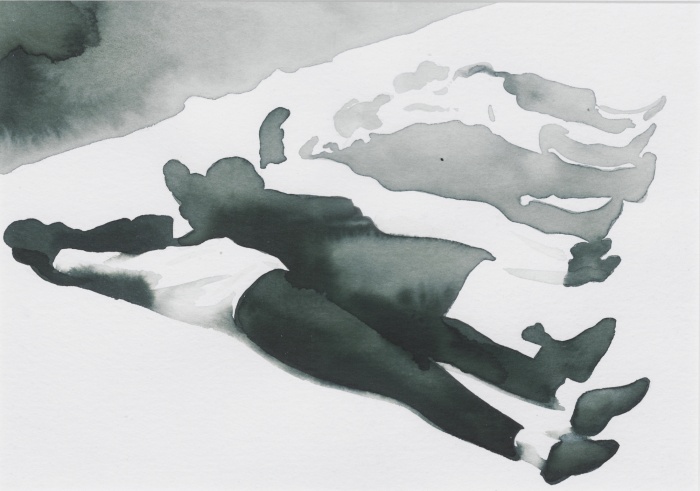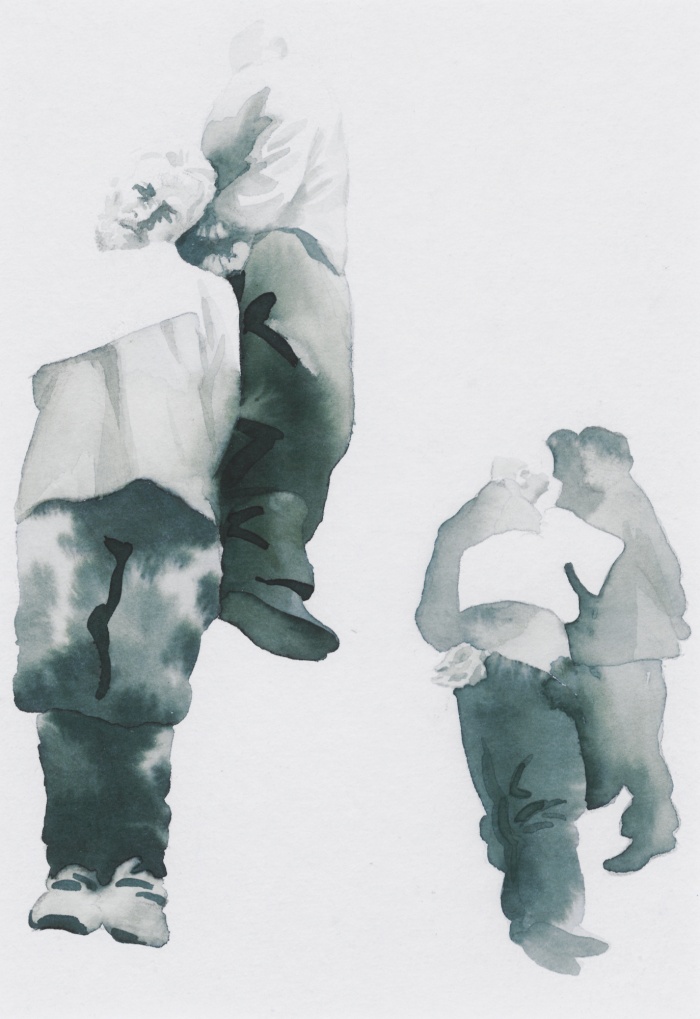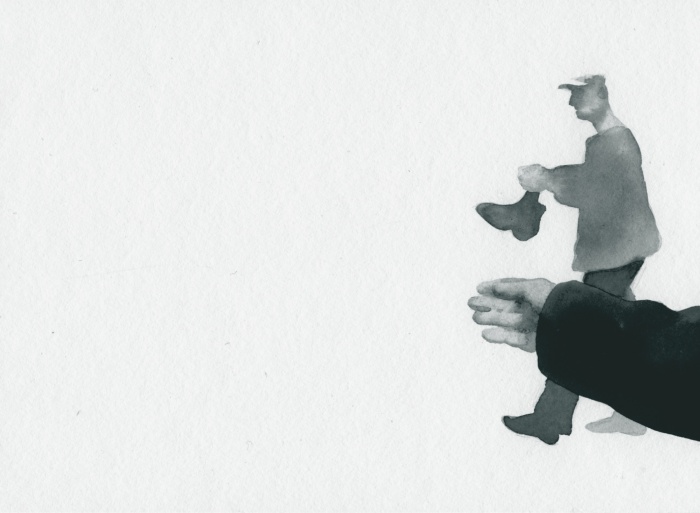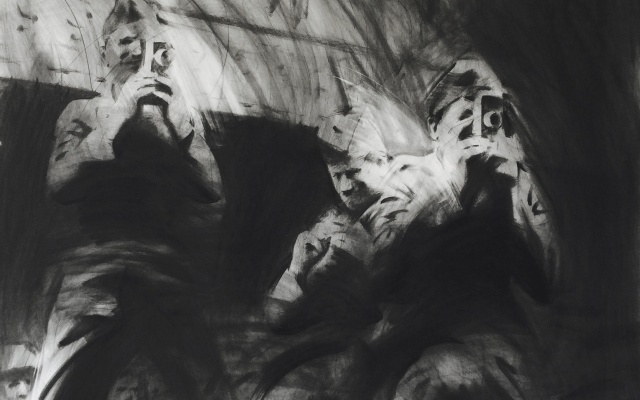After the kiss
Once an ideological edifice that up to now seemed unshakeable suddenly collapses, many of those who saw their own lives and the world around them faithfully mirrored in its dogmas, cannot stop wondering about their embarrassing loss of reality. It is as if they had believed in fairy tales. At least when it comes to the ideology of the post-communist transition, that impression is not far from the truth. In fact, it was but a sort of fairy tale, one that best resembles Sleeping Beauty: after spending decades in a deep totalitarian sleep, into which they were thrown by pricking their fingers on the poisonous ideas of Communism, the nations of Eastern Europe have finally awakened with a kiss of the Prince from abroad — democracy in its untainted innocence and sublime beauty. But, as usual, where a fairy tale ends, real life begins. Instead of “… and-they-lived-happily-ever-after …” the harsh reality has recurred: social dissolution, capitalist exploitation, global antagonisms, evil ghosts from the past, and the most perfidious of all politics – identity politics. The latter has immediately restaged the democratic revolution as its own solo play. Now it is all about “identity.”
On the one hand, the sudden collapse of the old order has sparked many new forms of emancipatory struggle. From ever-growing claims for gender equality to the “pride parades” on the streets of Eastern European cities, the rights of various minority groups have become important political stakes of democratic transition. Yet what looked like a progressive leap into a better democratic future was instantly overshadowed by regressive conflicts between nations and ethnic groups. The long-awaited liberation has opened the Pandora box of the worst forms of nationalism and chauvinism that in some places stoked horrific violence and even all-out wars, as in the former Yugoslavia (1991–1999).

Nikita Kadan, Mieszkańcy miasta. Z serii Kroniki, 2016. Tusz na papierze. 20 x 15 cm. Praca w kolekcji M HKA Museum w Antwerpii. Dzięki uprzejmości artysty.
The explanation for this backslide, offered by the ideology of the post-communist transition, sounded like a cheap Freudianism: nationalism in post-communist Eastern Europe is the result of a “return of the repressed.” Atavistic hatred of the “other,” originating in premodern times, was suppressed under the totalitarian rule and so kept unconscious in its primitive, irrational form; once the pressure was removed, it erupted with full force, dragging entire societies into regressive collapse. This is how the cause for violent outbursts of nationalism in the post-communist East was finally discovered in its endemic features, i.e. in its retarded cultural identity – itself seen as a consequence of the totalitarian rule that prevented its normal development, which would have otherwise ensured rational democratic control over primordial instincts. Thus, the ugly, nationalist side of the awakened Beauty has revealed itself to be an intrinsic part of her – “eastern” – identity. To put it simply, she was not of noble birth – in contrast to the Prince who arrived on the scene also with a ready-made identity, although a much nobler, “western” one.
The traumatic encounter of unequal identities has decisively determined the very character of the democratic revolutions of 1989/90. Regardless of the fact that democracy was clearly won by the masses of the “former East” and is undoubtedly a genuine achievement of their own struggle, it nevertheless appears as the exclusive property of someone else’s identity. Concretely, it appears under the guise of “Western value,” intrinsic to a very particular, culturally localized and geopolitically territorialized form of life. As a result, democracy has never felt at home in the East, for there it was and it has remained until today merely a copy whose original is somewhere else – in the West.
In fact, the entire ideological superstructure of the so-called “Fall of Communism” was built around the paradigm of identity politics. Not only has it determined the meaning of the historical event itself and the self-understanding of its subjects, it has also radically reframed the recent history and the very idea of political transformation. The latter, for instance, has completely lost its social dimension. Now it seemed that the agencies of political change are no longer moved by social causes. It also appeared that the change they were bringing about does not affect social relations either, which, anyway, they never address directly. Even the notion of social conflict suddenly looked out of place here. Those who once thought that the idea of a classless society is no more than a baseless Communist utopia were, after 1989, proven wrong. The protagonists of the post-communist transformation in Eastern Europe truly act as though their societies are already classless. Moreover, in their perception of the reality they seek to transform there is, to use the famous phrase of Margaret Thatcher, “no such thing as society.” There are, however, cultural differences instead, those between nations, ethnicities, religious affiliations or between large cultural spaces, the so-called “cultural circles” like “Europe,” “West,” “East,” “the Balkans” etc. And there is also a deep dark history full of traumatic experiences generated by these differences. To put it bluntly, for the political forces of the post-communist transition, the history of all hitherto existing society is the history of identity struggles.
Let God be their judge
Looking from this historical perspective, it is no wonder that the communist past must have become itself an identity issue. So is Communism now no longer seen as an – whether right or wrong – answer to the social problems caused by the immanent contradictions of the historical capitalism, but rather as a sort of alien identity, i.e., as a (culturally) foreign intruder who obstructed the pre-existing harmony of national community and broke an otherwise “normal” or “natural” continuity of its history.

Nikita Kadan, Oprawca o wyglądzie rewolucjonisty. Z serii Kronika, 2016. Tusz na papierze. 15 x 20 cm. Praca w kolekcji Galerii Arsenał w Białymstoku. Dzięki uprzejmości artisty.
This intruder has, in general, a proper national name, in most cases a Russian one. This is not difficult to understand when it comes to the countries of the former Warsaw Pact that were directly subjected to the political and military dominance of the Soviet Union. The masses of these countries had at least some reason to experience the communist rule as “Russian occupation.” This even worked outside of the Soviet Bloc, for instance in former Yugoslavia, where notions like “Yugo-Communism” or “Serbo-Communism” only confirm the general rule: in order to get rid of the Communist legacy, the ideology and politics of the post-communist transition attaches it to an odious foreign identity, as though there is something intrinsically “Russian” or “Serbian” in the ideas and political praxis of Communism.
The logic of identitarian exclusion was confirmed even in Russia itself, where the whole experience of historical Communism, as alien to the essentially Orthodox identity of the Russian nation, was retroactively packed into the notion of Bolshevism or personified in the name of Lenin and finally disposed of, for instance, to divine judgement: “Let God be their judge,” said Putin explicitly speaking of the Bolsheviks. It was 2014 when he accused them of giving away significant parts of Russian territory to Soviet Ukraine. In his end-of-2019 press conference he repeated it putting blame on Lenin personally. Turning the “ancestral Russian territories” over to Ukraine was his idea – which Stalin, as Putin argued, initially opposed. However, the ideological meaning of the blame was in fact entirely identitarian. Communism – in the historical guise of Lenin’s Bolsheviks – violated “the ethnic composition of those regions”; it was, so to say, at odds with the world of true human nature, which is but an ensemble of identity relations. As a genuine post- and anti-communist, Putin, and today’s Russian politics he personifies, aim at correcting this anomaly, inherited from the Communist past, (“And now we have to grapple with this.”) and bringing the reality back into harmony with human nature, which concretely means, redrawing the (communist) borders according to the proper identity relations. While Putin recognizes the existence of a Ukrainian identity, he nevertheless considers it somehow weaker or at least not yet properly developed so as to set itself clearly apart from the Russian one, which for him, of course, has the character of a full-fledged national identity. This, however, might make the concrete territorial rearrangements fairly difficult, yet the logic of (national) identity and its intrinsic relation to territory remains beyond doubt.
Cutting Communism and its ideological legacy out of the nation’s identity brings the advantage of restoring an alleged continuity of national history reduced to an abstract linear persistence of the nation through an empty time. What now, in the case of Russia, re-emerges out of the ruins of Communism is the old Russian Empire nicely cleaned of the traumatic legacy of its inner social contradictions or – God forbid! – class struggles and of Tsarist imperialism, both challenged in a no less traumatic way precisely by Lenin and the Bolsheviks. Needless to say, in such an arbitrarily purified national history one can also easily reincorporate anything that happened in the Soviet times as far as it serves current interests. One can not only celebrate the victory over fascism in WW2 as an exclusively “Russian” one, one can also repeat it presenting the occupation of Crimea as a no less victorious anti-fascist struggle.

Nikita Kadan. Praca z serii Kroniki, 2016. Tusz na papierze. 20 x 15 cm. Praca w kolekcji M HKA Museum w Antwerpii. Dzięki uprzejmości artysty.
Don’t mess with the West
Indeed, the Sleeping Beauty from the post-communist fairy tale is undoubtedly tainted, but the Prince who has awakened her is by no means an angel either. Like its eastern, post-communist counterpart, the West too is an identity creature, yet one that politically, economically, and culturally dominates the world. As a result, in the ideological self-presentation of the major subjects of the post-communist transition this whole historical event appears as a clash of identities. If history, long ago declared dead, moves nevertheless, it does so not in terms of social change but rather through identity claims. It becomes a sort of drama of belonging. Just like individuals have now no other choice than to commit themselves to a certain group identity, most notably a national one, nations are also forced to align themselves with larger identity blocks. This has radically reconceptualized the meaning of the post-communist transition. What initially started as a social transformation has soon evolved into a sort of identitarian re-alignment. Now, the great ideals of democracy, freedom, rule of law, economic and cultural prosperity, social stability etc., are to be achieved by joining the “West.” The process of democratic transformation that was originally even called a revolution has finally become synonymous with “westernization,” an essentially cultural move to the “West.”
For most of the former socialist countries this process has had a very concrete political and institutional form that could be summed up in the notion of the so-called “Euro-Atlantic integration,” which simply means their integration into the EU and NATO. But it also implies a shift in the sovereignty status and establishment of new border regimes: while both the sovereignty of the new member states and their borders within the EU have significantly weakened, its frontiers have gotten harder. Once within, one is also a member of a very exclusive club, the West. However, it is not a political institution; it does not have a democratically elected government; it has never been recognized by any other state and has never asked for that either; it might have a territory, but it is impossible to clearly map it and define its borders. All that, however, does not make it any less real. The West, nevertheless, exists in the effects of its enormous power. It is nothing but an identity with money, guns, and prestige. If you mess with the West, it can ruin you economically, bomb you into stone age, or cast you into oblivion. If, on the contrary, you enter its noble realm, you will certainly benefit from it. But nevertheless, it is still no more than an identity and no replacement for a democratic constitution. Moreover, the West is the very name for the historical crisis of democracy, for its failure to constitute itself outside of the territorial and institutional frame of the nation-state and beyond the concept of people’s sovereignty. In its ideological formation reveals itself to be an attempt by the most developed democracies of today’s world to escape the contradictions of neoliberal globalization through an encapsulation into this normative identity block, within which they hope to secure their global dominance. This is, however, a desperate attempt. It resembles Sigmund Freud’s concept of a “flight into illness” – a mechanism of defense by means of which a neurotic, in order to escape his or her inner conflicts, produces symptoms of a psychic illness. A perfect example of such an ideological symptom-formation has been recently offered by the European Union.

Nikita Kadan, Mężczyzna niosący buty. Z serii Kroniki, 2016. Tusz na papierze. 15 x 20 cm. Praca w kolekcji Galerii Arsenał w Białymstoku. Dzięki uprzejmości artysty.
Flight into a historical lie
On two occasions in recent years the European Parliament in Strasbourg adopted resolutions that deal with the past in terms of the EU distancing itself from the legacy of the so-called “two-totalitarianisms.” Both resolutions were passed by a vast majority of votes: the first on 2 April 2009 (by a vote of 533 MEPs for, 44 against and 33 abstained) in which it condemned totalitarian crimes and called for the recognition of “Communism, Nazism and fascism as a shared legacy”; the second on 19 September 2019, (535 MEPs voted for, 66 against and 52 abstained) concerned the “Importance of European remembrance for the future of Europe.” In both cases the EU has in fact adopted the logic of historical revisionism as its official narrative on history and policy of memory. While it manifestly declares two totalitarianism, Communism and Nazism/fascism as equally evil, it tacitly implies that the latter, Nazism is a sort of overreaction to “the original sin,” epitomized in the notion of Bolshevism – the position advocated in the late 1980s by German conservative historian Ernst Nolte, who considered both, Communism and Nazism as two forms of totalitarianism whereas Nazi crimes were seen as a “mere” copy of the original Bolshevik’s ones.
Let us put aside the falsity of this thesis that is so blatantly obvious in the second declaration, which claims that the Second World War was in fact triggered by the German-Soviet Non-Aggression Treaty. Much more important is its ideological use in the context of the deepening crises of the European Union, which is today, after Brexit, for the first time in its history confronted with the real danger of its disintegration. It is within this context that both Declarations represent an attempt – a very desperate indeed – at reconstitution of the European Union out of its substantial identity. More precisely, it is an attempt at providing the imaginary construct of a European identity with a “real” essence in the form of a common past, i.e., a shared legacy. People of Europe, as it is implicitly alleged in the Declarations, come together to form the Union not because of their common interests, or a common vision of a better future, but rather on the ground of a clearly defined common historical experience. This is explicitly claimed in both Resolutions: the first stating that “Europe will not be united unless it is able to form a common view of its history…” and the second, that talks of “the shared European legacy” of the crimes of totalitarian regimes as being of “vital importance of the unity of Europe and its people.” It goes without saying that such a common historical truth, approved by the European Parliament, facilitates the institutionalization of a common memory culture (the first Resolution) and legitimates an official politics of memory (the second Resolution). In this way, not only is the historical truth determined, or better, imposed by an arbitrary political decision, concretely, the majority of votes, it becomes also an instrument of power and a weapon in the political struggle that can be used against both, the internal and external enemies. Those for instance, who, like the European anti-fascists, cannot, or will not, recognize themselves in this historical “truth” – which is why they feel obliged to reject this memory culture and sabotage this politics of memory – will be automatically excluded from the “true” European identity, declared “foreign” to the common European culture (of memory) and denounced as political enemies of the European people. At the same time, such a substantial identity, essentialized in an official historical “truth,” requires a strong boundary as the protection from outer enemies, or, in the words of the second Resolution, is of “vital importance (…) for building European resilience to modern external threats.” Having in mind those who in fact initiated the second Resolution – the Baltic states and Poland – we know to whom actually refers the notion of “external threat” – to Russia, which, in this hostile projection, is curiously identified as the principal heir of the entire Communist legacy, and not, as the historical successor of the Tsarist imperialism and its reactionary values, which were then radically opposed by the Bolsheviks, but which, nowadays, have found their second life in an increasingly militarized, no less reactionary Putin’s oligarchy. Having bearing in mind the recent far-right populist shift in the European Union and, generally, in the West, we see how this hostile stance on the Russian intruder from the outside fully coincides with an increasingly aggressive, hostile stance towards the refugees and migrants of all sorts.
The way out
The post-communist anti-communism – a paradox in itself – has laid a stable ideological ground for the reconstitution of today’s crisis-ridden European Union, and the West in general, into a reactionary, post-democratic identity “block of hatred” – very much in the legacy of a Europe once united under the Nazi-Fascist rule, the Europe in which almost all of its nations established their own collaborationist regimes (which is why they have today so enthusiastically endorsed the politics of historical revisionism) – a perfect partner for a war with its equally reactionary, identity-obsessed, second-grade world power Russia.
Here one should remember the lesson learned from the violent dissolution of former Yugoslavia, a multiethnic, multi-confessional, multi-cultural Union of federative republics. The outcome is grim: few vassal states of the West for whose peoples the claim to sovereignty they once so proudly declared sounds today as a bad joke; the rest (Bosnia, Kosovo) is a sort of Western protectorate, in fact, the area of frozen conflict, in a permanent state of emergency with no prospect for ever returning to “normality,” i.e., to the order of sovereign nation-states.
This fully applies to Ukraine today. Once broken by forced identitarian alignment, it will never restore the previous unity of its territory nor the sovereignty of its people. There is no way back into the harmony of a single nation-state-democracy. It was a lie anyway. But there is, however, a way out, the only one that opens the prospect of emancipation – an escape from the cage of identity.
BIO
Boris Buden is a writer, cultural critic, and translator. He studied philosophy in Zagreb and received his PhD in Cultural Theory from Humboldt University, Berlin. In the 1990s he was editor of the magazine and publishing house Arkzin in Zagreb. He is a board member of the European Institute for Progressive Cultural Policies (eipcp), Vienna. His essays and articles cover topics related to philosophy, politics, translation, linguistics, the post-communist condition, and cultural and art criticism. Among his translations into Croatian are some of the most important works by Sigmund Freud. Buden’s writings appear in numerous books, including the BAK publication Concerning War: A Critical Reader in Contemporary Art (2006/2010) and Art and Contemporary Critical Practice: Reinventing Institutional Critique (2009). He has co-edited and authored several books, including: Zone des Übergangs: Vom Ende des Postkommunismus (2009); Übersetzung: Das Versprechen eines Begriffs (with Stefan Nowotny) (2008); and Der Schacht von Babel: Ist Kultur übersetzbar? (2004). He teaches cultural theory at the Faculty of Art and Design, Bauhaus University, Weimar. He lives in Berlin.
*Cover photo: Nikita Kadan. Courtesy of the artist.
“European Parliament resolution of 2 April 2009 on European conscience and totalitarianism”, https://www.europarl.europa.eu/sides/getDoc.do?pubRef=-//EP//TEXT+TA+P6-TA-2009-0213+0+DOC+XML+V0//EN
“European Parliament resolution of 19 September 2019 on the importance of European remembrance for the future of Europe”, http://www.europarl.europa.eu/doceo/document/TA-9-2019-0021_EN.html



